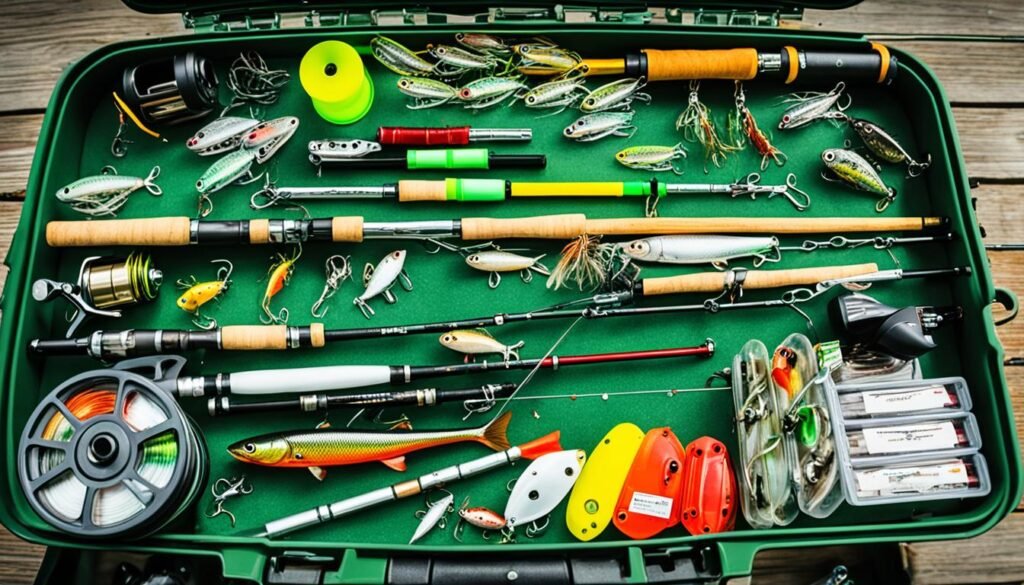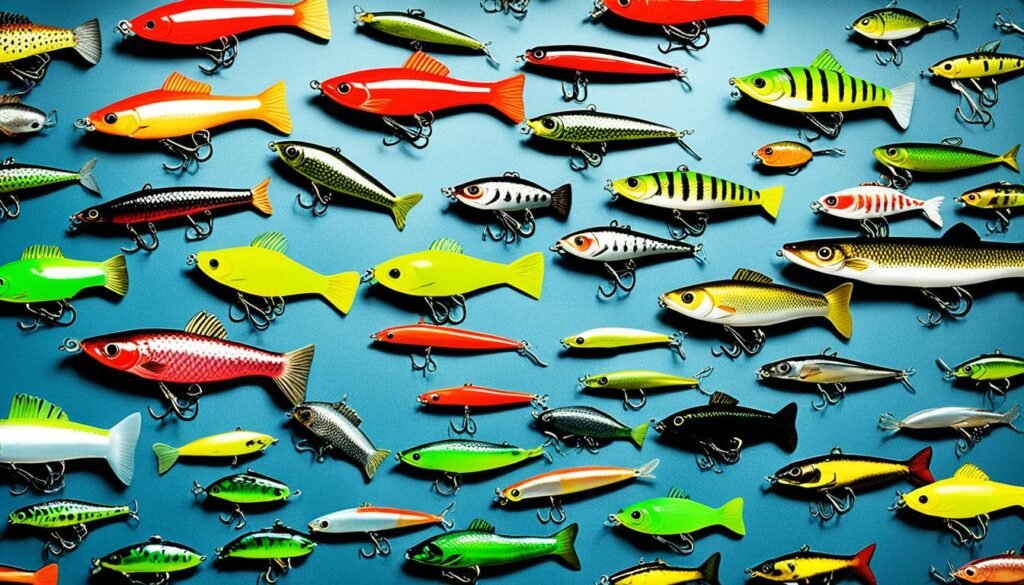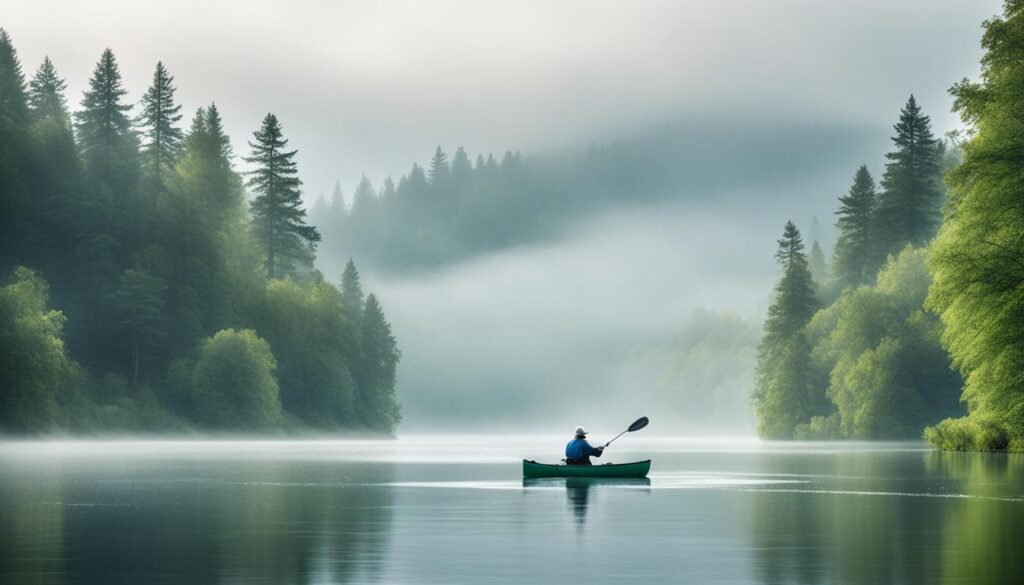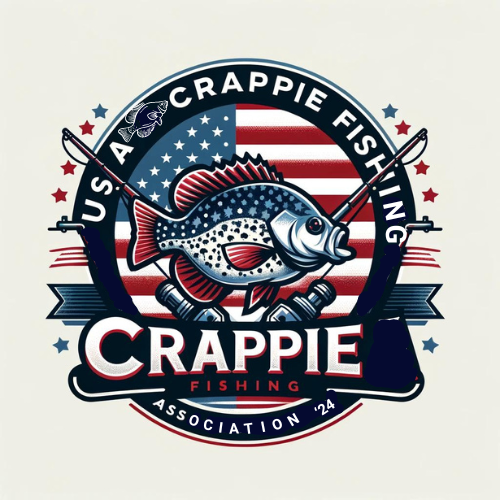“The charm of fishing is that it is the pursuit of what is elusive but attainable, a perpetual series of occasions for hope.” – John Buchan
Shore fishing has an undeniable allure. It’s a pursuit that offers bank anglers the opportunity to connect with nature, test their skills, and land monstrous freshwater giants. While walleye may be the first species that comes to mind when thinking about bank fishing, there are other formidable creatures lurking in the depths, waiting to be caught.
In this article, I will delve into the captivating world of bank fishing for big fish. I will share proven tactics and strategies that will help you dominate the shoreline and increase your chances of landing that trophy catch. Get ready to explore the exciting possibilities that await you beyond walleye and embark on a journey of shoreline adventures.
Key Takeaways:
- Shore fishing is a rewarding and effective way to catch big fish.
- Mastering bank fishing tactics and strategies can increase your chances of success.
- There are other freshwater giants beyond walleye waiting to be caught.
- Exploring the shoreline opens up a world of exciting fishing opportunities.
- Get ready to dominate shore fishing and reap the rewards of your efforts.
Understanding the Behavior of Big Pike
When it comes to pike fishing, understanding the behavior of these big predators is key to a successful catch. Northern pike, especially the larger ones, thrive in the cold waters of winter. They have high activity levels during the ice fishing season, making it an ideal time to target them. These freshwater giants are often found in mid-depth flats, where they can take advantage of the warmer water and accelerate their metabolism.
The warmer water in mid-depth flats makes big pike more likely to feed, presenting an excellent opportunity for bank anglers. By gaining insights into the behavior and habitat preferences of these pike, you can effectively target them and increase your chances of landing a trophy fish.
To further illustrate their behavior, let’s take a closer look at the preferred habitat and feeding patterns of big pike.
Pike Habitat Preferences
Big pike prefer mid-depth flats, where water temperatures are slightly warmer compared to deeper areas. These flats provide a comfortable environment for pike, facilitating their metabolism and making them more active. The availability of prey species and suitable cover, such as submerged vegetation or underwater structures, also attracts pike to these areas.
Understanding the preferred habitat of big pike is essential for choosing the right fishing spot and increasing your chances of a successful catch.
Pike Feeding Behavior
Pike are apex predators and opportunistic feeders. They are known for their aggressive strikes and voracious appetite. As ambush predators, they rely on their keen senses and lightning-fast strikes to catch their prey. Pike feed on a variety of prey species, including smaller fish, crayfish, frogs, and even small mammals.
Bank anglers can take advantage of pike’s feeding behavior by using bait or lures that closely mimic their natural prey. Understanding the preferred diet of big pike allows you to select the right bait and increase your chances of enticing a strike.
“Understanding the feeding habits and behavior of big pike can give you a significant advantage as a bank angler. By targeting their preferred habitat and using bait that imitates their natural prey, you can increase your chances of hooking into a trophy-sized pike.” – Experienced Angler
Now that we have a better understanding of the behavior of big pike, let’s explore the high-tech advantages that can further enhance your pike fishing experience.
Utilizing High-Tech Advantages for Pike Fishing
Advances in technology have revolutionized ice fishing for pike. By harnessing the power of high-tech tools and equipment, anglers can gain a significant edge in their pursuit of these freshwater giants. Sonar technology, underwater cameras, and advanced fish-finding systems allow anglers to precisely locate and target big pike, increasing their chances of a successful catch.
Sonar Technology: Unlocking the Depths
Sonar technology has become an invaluable asset for pike fishing enthusiasts. With its ability to provide detailed information on water depth and structure, sonar devices help anglers identify potential hotspots where big pike might be lurking. By scanning the underwater environment with 360-degree flexibility, anglers can pinpoint the exact location of these elusive predators. Garmin’s Panoptix Ice Fishing system, for example, offers real-time sonar imagery, allowing anglers to visualize the fish and assess their behavior.
Underwater Cameras: Revealing the Hidden
Underwater cameras have emerged as a game-changer in pike fishing, providing unparalleled visibility beneath the icy surface. Aqua-Vu’s high-definition underwater cameras, for instance, allow anglers to peer into the depths and observe the pike in their natural habitat. These cameras can reveal the presence of large pike even when they appear to be immobile, giving anglers the opportunity to strategize and present their bait more effectively.
“Underwater cameras can really give you an edge in pike fishing. Seeing the fish in real-time allows you to adjust your presentation and target the biggest ones.” – Bill Johnson, experienced pike angler.
Panoptix Ice Fishing: A Panoramic View
The Garmin Panoptix Ice Fishing system combines the advantages of sonar technology and underwater cameras to provide a comprehensive view of the underwater world. This advanced system offers a 360-degree panoramic view, allowing anglers to visualize the entire area and detect the presence of big pike. By observing their behavior and movements, anglers can make informed decisions about bait presentation and increase their chances of enticing a strike.
| Advantages | High-Tech Pike Fishing Tools |
|---|---|
| Accurate fish location | Panoptix Ice Fishing |
| Real-time sonar imagery | Panoptix Ice Fishing |
| Live underwater visibility | Aqua-Vu high-definition underwater cameras |
| 360-degree fish scanning | Panoptix Ice Fishing |
Enhancing Your Pike Fishing Setup
To increase your chances of catching big pike, it’s important to optimize your fishing setup. Consider using larger holes and robust tip-ups to accommodate for the size and power of these freshwater giants. Choose the appropriate line, such as Sufix Performance metered tip-up line and Seaguar fluorocarbon leader, for both visibility and durability. Use dead bait in the 8- to 12-inch range and opt for a quick-strike harness to maximize hooking efficiency.
When targeting big pike, having the right fishing gear can make a significant difference. Here are some essential items to enhance your pike fishing setup:
Pike Fishing Gear
Investing in high-quality pike fishing gear is crucial for a successful fishing expedition. Opt for sturdy fishing rods and reels that can withstand the fight of a large pike. Choose a rod with enough backbone to handle the weight and power of big fish, and pair it with a reel that provides smooth line retrieval.
Tip-Ups
Using tip-ups is an effective technique when targeting pike. These devices allow you to fish multiple holes simultaneously, increasing your chances of catching a trophy-sized pike. Invest in tip-ups that are specifically designed for pike fishing, as they often have features like heavy-duty construction and large spools to handle thicker lines.
Line Selection
Selecting the right fishing line is crucial when targeting big pike. Consider using metered tip-up line, such as Sufix Performance, which features easily visible colored sections for better depth perception and strike detection. Additionally, choose a fluorocarbon leader like Seaguar, which offers excellent invisibility and abrasion resistance to withstand the sharp teeth of pike.
Bait and Terminal Tackle
Pike are opportunistic predators and can be caught using a variety of bait and terminal tackle. When using dead bait, opt for larger sizes in the 8- to 12-inch range to attract the attention of big pike. Quick-strike harnesses are popular among pike anglers as they allow for a more efficient hookset, increasing your chances of landing these powerful fish.
Enhancing your pike fishing setup with the right gear, tip-ups, line selection, and bait can significantly improve your chances of landing trophy-sized pike. By investing in quality equipment and utilizing effective techniques, you’ll be well-prepared to tackle the challenge of catching these freshwater giants.
| Essential Pike Fishing Gear | Recommended Brands |
|---|---|
| Fishing Rod and Reel | St. Croix, Abu Garcia |
| Tip-Ups | Frabill, HT Enterprises |
| Fishing Line | Sufix, PowerPro |
| Fluorocarbon Leader | Seaguar, Sunline |
| Bait | Large dead baitfish, suckers |
| Terminal Tackle | Quick-strike harnesses, treble hooks |

“Having the right fishing gear is crucial for a successful pike fishing expedition. Investing in quality gear and equipment increases your chances of landing trophy-sized pike.”
By enhancing your pike fishing setup with the appropriate gear, tip-ups, line selection, and bait, you’ll be well-equipped to tackle the challenge of landing these powerful and elusive freshwater giants.
The Art of Lure Selection
Choosing the right fishing lure is crucial for attracting and enticing big fish. There are various lure types available, each with its own unique characteristics and applications. To maximize your chances of success, it’s important to understand the different lure types and their benefits.
Soft Plastics
Soft plastics are versatile lures that can imitate a wide range of prey species. They come in various shapes and sizes, such as worms, grubs, and swimbaits. Soft plastics can be rigged with different hooks and weights, allowing you to fish them at different depths and speeds. These lures excel in situations where a natural presentation and finesse are required. Whether you’re targeting bass, walleye, or trout, soft plastics can be an effective choice.
Crankbaits
Crankbaits are hard-bodied lures with a diving lip that allows them to reach different depths in the water. They come in various sizes and colors, imitating different types of baitfish. Crankbaits are ideal for covering large areas of water quickly, searching for actively feeding fish. Their erratic swimming action and attractive vibrations can provoke aggressive strikes from predator fish like bass, pike, and muskie.
Spoons
Spoons are metal lures with a concave shape resembling a spoon. They have a smooth and shiny surface that reflects light, imitating an injured or fleeing baitfish. Spoons are versatile lures that can be cast, trolled, or jigged. They are effective for both freshwater and saltwater fishing and can catch a wide range of species, including salmon, trout, and pike. Their simple design and enticing fluttering action make them a go-to lure for many anglers.
Jigs
Jigs consist of a weighted head and a hook, often adorned with a soft plastic or hair skirt. They can be used with various trailers, such as crawfish imitations, plastic grubs, or minnow bodies. Jigs are versatile lures that can be fished in different ways, including casting, flipping, or jigging. They excel at imitating bottom-dwelling prey like crawfish and minnows. Jigs are often used for bass, walleye, and panfish fishing but can also catch larger species like muskie and pike.
Understanding the characteristics and applications of these lure types is essential for successful fishing. Experiment with different lures, colors, and retrieval techniques to find what works best for your target species and fishing conditions.

| Lure Type | Characteristics | Applications |
|---|---|---|
| Soft Plastics | Versatile, imitates various prey species | Bass, walleye, trout |
| Crankbaits | Diving lip, erratic swimming action | Bass, pike, muskie |
| Spoons | Reflective surface, imitates injured baitfish | Salmon, trout, pike |
| Jigs | Weighted head, versatile | Bass, walleye, panfish |
Researching Fish Species and Their Preferences
To effectively target big fish, it’s important to understand the feeding habits and preferences of the fish species you are targeting. Different species have different diets and preferred habitats. Researching the primary food sources and habitat preferences of your desired fish can help you select a bait that closely imitates their natural prey. This knowledge will significantly increase your chances of success when fishing from the bank.
When it comes to fishing, knowledge is power. By conducting thorough research on the fish species you plan to target, you can gain valuable insights into their preferred habitats, feeding patterns, and behavior. This information will enable you to make informed decisions regarding your fishing techniques, bait selection, and location choices, ultimately increasing your chances of landing the big fish you desire.
One effective way to research fish species and their preferences is through reliable online resources, such as government fish and wildlife agencies, reputable fishing websites, and scientific publications. These sources often provide comprehensive information on various fish species, including their habitat preferences, preferred food sources, and seasonal behavior.
In addition to online resources, leveraging the knowledge and experiences of local anglers and fishing guides can also be highly beneficial. These individuals have hands-on experience fishing in your target area and can offer valuable insights into the specific fish species you are targeting. Engaging in conversations with experienced anglers and joining fishing forums can provide you with practical tips and recommendations based on their firsthand experiences.
To organize and retain the information you gather during your research, consider creating a comprehensive table that outlines the key details of each fish species, including their preferred habitats and primary food sources. This table will serve as a valuable reference guide when selecting baits and determining the best fishing spots.

| Fish Species | Preferred Habitat | Primary Food Source |
|---|---|---|
| Largemouth Bass | Weedy areas, submerged structures | Frogs, small fish, crayfish |
| Northern Pike | Weedy areas, shallow bays | Minnows, small fish, frogs |
| Walleye | Rocky structures, drop-offs | Perch, minnows, insects |
By examining the table above, you can quickly determine that if you are targeting largemouth bass, you should focus on fishing in weedy areas and using bait that resembles frogs, small fish, or crayfish. On the other hand, if you are targeting northern pike, you should look for weedy areas and shallow bays, and use bait that resembles minnows, small fish, or frogs.
Remember, every fish species has its own unique preferences and behaviors. By understanding these nuances and tailoring your fishing approach accordingly, you can increase your chances of attracting and hooking those big fish.
Adapting to Fishing Conditions
Fishing conditions have a significant impact on the success of your fishing expedition. Several factors such as water clarity, temperature, weather, and time of day can influence fish behavior and their response to different baits. Understanding and adapting to these conditions can greatly increase your chances of success.
Water Clarity
The clarity of the water you are fishing in plays a crucial role in bait selection. In clear water, fish can easily detect subtle movements and details, so a more natural and subtle presentation is often required. Use baits that closely resemble the prey species found in that environment. On the other hand, in murky water or conditions with low visibility, brighter and more attention-grabbing baits can be effective in attracting fish.
Temperature
Water temperature is another important factor that can impact fish behavior. Different species have their preferred temperature ranges, and their activity levels can vary accordingly. Understanding the temperature preferences of the fish you are targeting can help you determine the best times to fish and the most suitable baits to use. For example, cold-water species like trout may be more active in cooler temperatures, while warm-water species like bass may be more active in warmer temperatures.
Weather
The weather conditions, such as rain, wind, and sunlight, can also influence fish behavior. Rain can cause a temporary increase in water flow and oxygen levels, stimulating fish activity. Wind can create ripples on the water surface, making it more difficult for fish to see bait near the surface. In sunny conditions, fish may seek shelter in deeper waters or under structures. Understanding how weather conditions affect fish behavior can help you select the appropriate fishing spots and adjust your fishing techniques accordingly.
Time of Day
The time of day can greatly influence fish feeding patterns. Some species are more active during specific times, such as dawn and dusk, while others may be active throughout the day or prefer nighttime feeding. Observing fish activity levels during different times of the day can help you determine the best fishing times and the most productive techniques. Experimenting with various baits and presentations during different times can increase your chances of enticing a bite.
Adapting your bait selection to the prevailing fishing conditions is a key strategy to optimize your success on the water. By considering factors such as water clarity, temperature, weather, and time of day, you can make informed decisions and increase your chances of landing a prized catch.

| Fishing Conditions | How it Affects Fish Behavior |
|---|---|
| Water Clarity | Determines the type of bait and presentation that will be effective in different water conditions. |
| Temperature | Influences fish activity levels and their movement within the water column. |
| Weather | Affects fish behavior by creating changes in water flow, oxygen levels, and visibility. |
| Time of Day | Indicates the most active feeding periods when fish are most likely to bite. |
Selecting the Right Freshwater Fishing Gear
As a bank angler, I understand the importance of having the right freshwater fishing gear to optimize my fishing experience. Whether I’m targeting walleye, pike, or bass, using the appropriate tools and equipment can greatly enhance my chances of success. Here are some key considerations when selecting your fishing gear:
Fishing License and Safety
Before heading out to your favorite fishing spot, it’s crucial to obtain the necessary fishing license and ensure you are abiding by local fishing regulations. This not only keeps you compliant with the law but also helps to conserve our precious fish populations for future generations. Additionally, prioritizing safety is paramount. Always wear a life jacket when fishing from a boat or fishing in unfamiliar waters. Be aware of potential hazards such as sharp fishing hooks and take precautions to prevent accidents.
Fishing Rod and Reel
Choosing the right fishing rod and reel combination is essential for effectively presenting your bait. Consider the type of fish you are targeting and the fishing techniques you will be employing. For example, if you are casting lightweight lures for bass, a medium-power spinning rod and reel setup would be suitable. On the other hand, if you are trolling for big pike, a medium to heavy-action baitcasting rod and reel would be more appropriate. Take into account the species you’ll be targeting and the fishing conditions you’ll be facing to make an informed decision.
Lure Selection
When it comes to lure selection, choosing baits that closely resemble the natural prey of the fish you are targeting is key. Take into consideration the feeding habits and preferred forage of your desired fish species. For example, if you are targeting walleye, consider using jigs tipped with live bait like minnows or leeches. If pike are your target, large spoons or swimbaits that mimic injured or fleeing baitfish can be effective. Experiment with different lure types and colors to find what works best for your target species and fishing conditions.
| Gear | Description |
|---|---|
| Fishing Rod and Reel | The right combination can make all the difference in presenting your bait effectively. |
| Fishing Line | Choose the appropriate line strength and type based on your target species and fishing conditions. |
| Terminal Tackle | Consider using appropriate hooks, sinkers, and swivels to improve hooking and presentation. |
| Tackle Box | An organized tackle box will help you carry and access your gear efficiently. |
| Fishing Accessories | Don’t forget essential items like pliers, line clippers, and a landing net. |
Remember, having the right freshwater fishing gear can greatly enhance your angling experience and increase your chances of success. Take the time to research and invest in quality equipment that suits your fishing needs. By being well-prepared and equipped, you’ll be ready to tackle any fishing adventure that comes your way.
Exploring Freshwater Fishing Locations and Timing
Freshwater fishing provides anglers with a diverse array of locations and opportunities to pursue their passion. Whether you prefer the tranquility of natural lakes, the flowing currents of rivers and streams, or the convenience of artificial lakes, reservoirs, and flowages, there is a fishing spot to suit every angler’s preferences.
Each fishing location offers its own set of unique experiences and opportunities. Natural lakes, for example, often boast abundant fish populations and scenic surroundings. Rivers and streams, on the other hand, provide dynamic fishing environments where fish congregate in specific areas based on the current and submerged structures.
Artificial lakes, reservoirs, and flowages are created by humans for various purposes such as water supply, hydroelectric power, or flood control. These man-made water bodies can provide excellent fishing opportunities, as they often support thriving fish populations.
Ponds are another popular freshwater fishing spot. These small bodies of water can be found in a variety of environments, such as parks, golf courses, or private properties. Ponds can offer a peaceful fishing experience and are often home to various fish species.
Understanding seasonal changes and the effects of water temperature is crucial for successful freshwater fishing. Fish species exhibit different behaviors and feeding patterns based on the time of year and water temperature. For example, during the warmer months, fish may become more active and migrate to shallower areas. In contrast, colder water temperatures may cause fish to seek deeper waters or become less active overall.
To optimize your fishing success, research the seasonal preferences of the fish species you are targeting. This knowledge will help you determine the best fishing locations and timing for each species throughout the year.
Conclusion
Freshwater fishing is an exhilarating sport that offers bank anglers the opportunity to catch big fish from the shoreline. By incorporating the freshwater fishing tips, bank angling strategies, and techniques discussed in this article, you can significantly enhance your chances of success. Understanding fish behavior, leveraging high-tech fishing advancements, making informed bait selections, adapting to fishing conditions, and choosing the right gear are vital aspects of successful shore fishing.
Researching fish species and their preferences is essential for selecting baits that closely mimic their natural prey. Additionally, adapting to fishing conditions such as water clarity, temperature, weather, and time of day can significantly impact your bait selection and fishing success. Exploring different freshwater fishing locations and timing allows you to target specific species and maximize your chances of catching big fish.
In conclusion, by applying these freshwater fishing tips, techniques, and strategies, you can take your bank angling skills to the next level and reel in the giants. With the right knowledge, preparation, and perseverance, you can dominate shore fishing and experience the thrill of landing big fish consistently. So grab your gear, hit the shoreline, and embark on your freshwater fishing adventure today!
